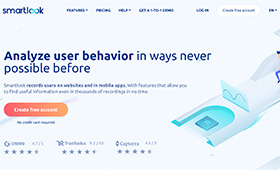Psychology derived from UX Analytics used in Web Design
What lies at the end of all the means of a UX designer? It is, of course, the user. However, throughout the entire process of figuring out how to attract users, make them to what you want them to do, and leading them to click on a specific button, it isn’t uncommon for a designer to forget that they are merely people.
In order to design for the people, you need to truly understand them – their behavior, motivation, and how it is that they make the decisions that they make.
This is where we move away from the field of UX design and find ourselves discussing psychology. It is necessary that you see UX design a combination of various fields, with psychology quite probably being the essential one. It could be cognitive, behavioral, or emotional psychology. They all provide you with the study of your users as people, and the knowledge of how to properly approach UX and web design.
The Psychology of Choice
Today, UX design focuses a lot on personalizing and customizing its approach. This would make you think that it would be a good idea to present your users with as many choices as possible. The more choices out there, the better chance that they find what is right for them, right? Wrong. The analytics have actually shown that when a user is given a staggering amount of options, they will most likely choose to go for neither of them. This is often referred to as decision paralysis and is one of those misconceptions we have about our users.
There is no formula that is going to tell you what the optimal number of choices on your site is. Some have argued that the best solution is to go with no more than five. Remember, it is important not to make your users feel overwhelmed, or they will more likely leave your website than do something.
Side note: Barry Schwartz wrote an excellent book on the topic, titled “The Paradox of Choice – Why More is Less“.
Substance overlooks
The fact is that UX is a lot more than just the package. While you may attract people at first with something that looks good, if they don’t find high-quality content that they can relate to, they will soon leave and never return. A website that offers high-quality content has a lot more traffic in the long run.
So, with having the psychological principle “substance over looks” in mind, you need to make sure that there is something really good beyond all the shiny visuals. Research what kind of content your users are looking for. Find out what they want to know, and help them find the answers. In the end, quality goes hand in hand with credibility.
Create a visual hierarchy
A user will more probably do what you want them to if you make it simple and easy. This is why it is necessary to have a strategic approach to your design. First, focus on the big and the bold. These are the website elements that your users will see first. If you want a piece of your content to be read, make the heading big. If you want something to be clicked on, use a different color so that they realize that it’ll lead them elsewhere.
According to the advice of a WordPress developer from Sydney, it is important that you don’t overdo your design. You want your users to do the familiar things, such as clicking a button, with ease. They will most likely interact with an item on your website if they know what it is, how it is supposed to be used, and what the outcome will be. Always make the calls-to-action obvious, such as placing them right under the elaboration of your product or service.
People rather scan than read
According to psychology studies, when people visit a website, they mainly process the information subconsciously. They do not read each and every detail but scan the page instead. The eyes are generally focused on the center of the page. Everything that lies on the edges is usually ignored unless someone really decides to play close attention. Therefore, the center is where your most important information needs to be.
This kind of content is called anchor information. Now, if your website demands that your visitors take a load of information, they will most likely decide that it is too much for them and leave. The fact is that many websites out there offer the same kind of service. So, if your website is one that exhausts visitors with a bunch of crowded information, they will simply refuse to endure it. In psychology, it is known that people endure things only when they have to.
In order to make use of the fact that people process websites subconsciously, you can use images strategically. They should draw the user’s attention in the direction you want it to go. The same goes for using colors and fonts. Finally, it is known that people view web pages in F-Shape.
Get personal with your users
The fact is that people are social creatures, and tend to trust other people. When it comes to website design, and digital marketing in general, it means that it is a great idea to make use of human faces.
There are two ways why this works so well. First, people are attracted to faces and will instantly look for clues when they see them. Second, due to the fact that people examine faces this way, you can use your images to express many things. For example, you can show people who are happy with using your product or engaging with one of your employees.
The Framing Principle
If you are the kind of website that offers services in packages, then you probably already know what the framing principle is. Some people like to refer to this principle as the Goldilocks technique. It’s basically a brilliant psychological method to apply when you are offering multiple choices to your users. Your intention is to present them the best way possible so that you have an effect on what the user will decide.
The user is most commonly presented with three choices in a row. There is a small option, a medium option, and a large option. According to the users of the Goldilocks technique, people will most commonly go for the middle one, as it seems like just the right compromise. Basically, you sandwich the best option between two extreme ones and drive your users to go for it.
Don’t test your user’s patience
Most people really don’t feel comfortable with filling out long forms. If your users need to register, the process needs to be quick and easy. If it is an overwhelming process, a lot of people will just give up even before they are halfway done. Therefore it is important that you make sure that any field that isn’t really necessary is removed. This way you will make sure that your users only need to fill the fields that are really important. Furthermore, don’t complicate the verification process. A simple click on a link does the job just right.
Conclusion
The conclusion is that, if you want to do your web design right and provide people with a quality UX, you need to dive into the waters of psychology. You need to know how your users think, what drives them to make a certain decision, and what pushes them away. You need to provide people with quality content but never overburden them with what you’ve got to present.
Side note: If you’re really interested to know more about how psychology is being used in design, you might want to look into our psychology section.








No responses yet to “Psychology derived from UX Analytics used in Web Design”